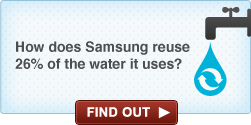The lush spring in Central Texas may have erased some memories of last year’s record-breaking drought, but that harsh reality lingers in our minds — and for good reason. Lakes Buchanan and Travis hover at around 50 percent capacity as we move toward summer.
Our strained water resources have become a top concern for communities and businesses. The drought may continue while the Austin metropolitan area is projected to grow to 2.7 million people by 2025. These facts deliver a mandate to protect and conserve this limited resource.
Central Texas’s ability to grow and prosper is wholly dependent upon its access to clean water. So is Samsung’s. Water conservation for us is a good business practice but we see its necessity on a broader level. Thoughtful resource management will ensure the future of this community and our place in it. We’re compounding our efforts by encouraging this culture with our vendors and collaborating with other business on what it takes to be green.
At Samsung, we’ve integrated water conservation into the fabric of our operations. We like to think that we borrow the water. We get it, use it, clean it up and return it.
The semiconductor chip manufacturing process is a water-intensive business, so conservation means a huge savings for us. Because we require large amounts of super-clean water, we treat about 130 million gallons of Austin’s tap water a month in two on-site water treatment plants. We recycle about 25 percent of the water we use by sending it to cooling towers and other operations. After some loss to evaporation, every month we return about 110 million gallons of treated wastewater to the city’s sewer system.
But we think there is always room for improvement. We’re constantly asking, “Are there other techniques we can use to reduce our overall consumption?” A team of our engineers is now considering changes that would allow us to reclaim more water from our processes — up to 45 percent.
It takes billions of dollars in investments to operate facilities such as ours, and any changes we make will be a significant financial investment. We make these investments not because we’re going to make money doing it but because conserving water is the right thing to do.
Our other water conservation initiatives include:
- All landscape irrigation on our 300-acre campus comes from air conditioning condensation – more than 500,000 gallons of recycled water annually.
- Eighty percent of the landscaping on our grounds features native, drought-tolerant plants.
- Bathrooms throughout our campus use water-efficient fixtures.
- Staff routinely survey our 2.4 million-square-foot facility for leaking valves and use pressure control devices to check for leaks, which are quickly repaired.
- Employees’ suggestions for how to reduce our environmental footprint are encouraged. One of those ideas caused us to shut down the fountain on our campus years ago.
Through our participation in the city of Austin’s Green Business Leaders program we share information about our environmental conservation achievements with other businesses and evaluate our performance against theirs. We learn from their techniques and consider how we could use them. When it comes to conservation, companies are very willing to share successes with their peers.
Yes, we’re a business and we need to make a profit. But at the same time, we must aim to be good corporate citizens and good corporate leaders and that means not consuming our natural resources thoughtlessly.
It’s not a financial return on investment; it’s an environmental return on investment.





